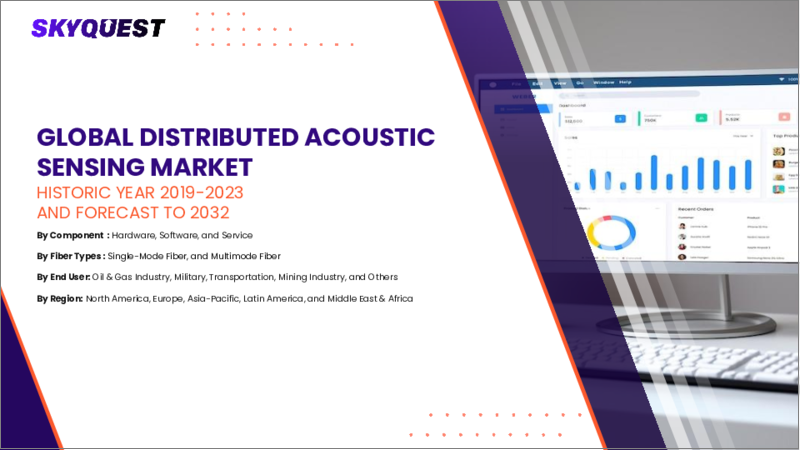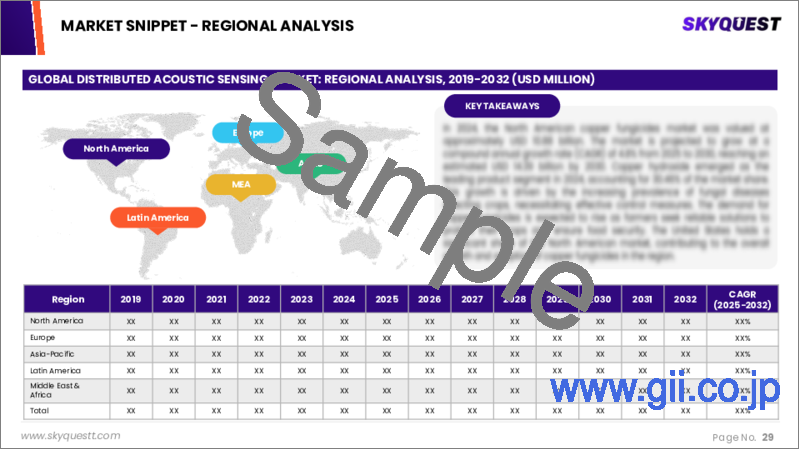|
|
市場調査レポート
商品コード
1647571
分散型音響センシングの市場規模、シェア、成長分析:ファイバー別、コンポーネント別、用途別、地域別 - 産業予測 2025~2032年Distributed Acoustic Sensing Market Size, Share, and Growth Analysis, By Fiber (Single-Mode Fiber, Multimode Fiber), By Component (Hardware, Software), By Application, By Region - Industry Forecast 2025-2032 |
||||||
|
|||||||
| 分散型音響センシングの市場規模、シェア、成長分析:ファイバー別、コンポーネント別、用途別、地域別 - 産業予測 2025~2032年 |
|
出版日: 2025年01月29日
発行: SkyQuest
ページ情報: 英文 157 Pages
納期: 3~5営業日
|
全表示
- 概要
- 目次
分散型音響センシングの世界市場規模は、2023年に5億6,750万米ドルと評価され、2024年の6億552万米ドルから2032年には10億1,729万米ドルに成長し、予測期間(2025~2032年)のCAGRは6.7%で成長する見通しです。
分散型音響センシング(DAS)市場は急速に進化しており、高感度音響センサーとして光ファイバーネットワークを革新的に利用することで産業を変革しています。石油・ガス、運輸、インフラ、セキュリティの各分野のアプリケーションにまたがるDASは、リアルタイムのモニタリングを可能にし、業務効率と安全性を大幅に向上させます。例えば石油・ガス分野では、DASは継続的な地震データを提供することで坑井モニタリングと貯留層管理に革命をもたらし、生産の最適化と漏れの早期発見に役立ちます。運輸業界では、鉄道や橋梁のような重要なインフラの構造健全性監視から恩恵を受け、DASは効果的な周辺監視を通じてセキュリティも強化します。各産業が意思決定の改善に正確なリアルタイム・データを求める中、DASソリューションの需要は、継続的な技術進歩と光ファイバー・ネットワークの拡張に後押しされ、急増することが予想されます。
目次
イントロダクション
- 調査の目的
- 調査範囲
- 定義
調査手法
- 情報調達
- 二次データと一次データの方法
- 市場規模予測
- 市場の前提条件と制限
エグゼクティブサマリー
- 世界市場の見通し
- 供給と需要の動向分析
- セグメント別機会分析
市場力学と見通し
- 市場概要
- 市場規模
- 市場力学
- 促進要因と機会
- 抑制要因と課題
- ポーターの分析
主な市場の考察
- 重要成功要因
- 競合の程度
- 主な投資機会
- 市場エコシステム
- 市場の魅力指数(2024年)
- PESTEL分析
- マクロ経済指標
- バリューチェーン分析
- 価格分析
- 規制情勢
- ケーススタディ
- 技術の進歩
分散型音響センシング市場規模:ファイバー別
- 市場概要
- シングルモードファイバー
- マルチモードファイバー
分散型音響センシング市場規模:コンポーネント別
- 市場概要
- ハードウェア
- DAS尋問ユニット
- ソフトウェア
- サービス
- 設置サービス
- メンテナンスサービス
分散型音響センシング市場規模:用途別
- 市場概要
- パイプライン監視
- 電源ケーブル監視
- 海底ケーブル監視
- 境界監視
- 火災検知
- 鉄道監視
- 交通機関
- その他
分散型音響センシング市場規模
- 北米
- 米国
- カナダ
- 欧州
- ドイツ
- スペイン
- フランス
- 英国
- イタリア
- その他欧州地域
- アジア太平洋地域
- 中国
- インド
- 日本
- 韓国
- その他アジア太平洋地域
- ラテンアメリカ
- ブラジル
- その他ラテンアメリカ地域
- 中東・アフリカ
- GCC諸国
- 南アフリカ
- その他中東・アフリカ
競合情報
- 上位5社の比較
- 主要企業の市場ポジショニング(2024年)
- 主な市場企業が採用した戦略
- 市場の最近の動向
- 企業の市場シェア分析(2024年)
- 主要企業の企業プロファイル
- 会社概要
- 製品ポートフォリオ分析
- セグメント別シェア分析
- 収益の前年比比較(2022~2024年)
主要企業プロファイル
- Halliburton Company(United States)
- Schlumberger Limited(United States)
- Baker Hughes Company(United States)
- Fotech Solutions Ltd.(United Kingdom)
- Future Fibre Technologies Pty Ltd.(Australia)
- Bandweaver Technologies Ltd.(United Kingdom)
- Omnisens SA(Switzerland)
- Ziebel AS(Norway)
- AP Sensing GmbH(Germany)
- Hifi Engineering Inc.(Canada)
- QinetiQ Group PLC(United Kingdom)
- Luna Innovations Incorporated(United States)
- Northrop Grumman Corporation(United States)
- Geocomp Corporation(United States)
- SmartPipe Technologies(United States)
- 3D-Radar(Norway)
- VIAVI Solutions Inc.(United States)
結論と推奨事項
Global Distributed Acoustic Sensing Market size was valued at USD 567.5 million in 2023 and is poised to grow from USD 605.52 million in 2024 to USD 1017.29 million by 2032, growing at a CAGR of 6.7% during the forecast period (2025-2032).
The Distributed Acoustic Sensing (DAS) market is rapidly evolving, transforming industries through its innovative use of optical fiber networks as sensitive acoustic sensors. Spanning applications in oil and gas, transportation, infrastructure, and security, DAS enables real-time monitoring, significantly enhancing operational efficiency and safety. In the oil and gas sector, for instance, DAS revolutionizes well monitoring and reservoir management by delivering continuous seismic data, aiding in production optimization and early leak detection. The transportation industry benefits from structural health monitoring for critical infrastructures like railways and bridges, while DAS also strengthens security through effective perimeter monitoring. As industries seek precise, real-time data for improved decision-making, the demand for DAS solutions is set to surge, driven by ongoing technological advancements and fiber optic network expansion.
Top-down and bottom-up approaches were used to estimate and validate the size of the Global Distributed Acoustic Sensing market and to estimate the size of various other dependent submarkets. The research methodology used to estimate the market size includes the following details: The key players in the market were identified through secondary research, and their market shares in the respective regions were determined through primary and secondary research. This entire procedure includes the study of the annual and financial reports of the top market players and extensive interviews for key insights from industry leaders such as CEOs, VPs, directors, and marketing executives. All percentage shares split, and breakdowns were determined using secondary sources and verified through Primary sources. All possible parameters that affect the markets covered in this research study have been accounted for, viewed in extensive detail, verified through primary research, and analyzed to get the final quantitative and qualitative data.
Global Distributed Acoustic Sensing Market Segments Analysis
Global Distributed Acoustic Sensing Market is segmented by Fiber, Component, Application and region. Based on Fiber, the market is segmented into Single-Mode Fiber and Multimode Fiber. Based on Component, the market is segmented into Hardware, Software and Service. Based on Application, the market is segmented into Pipeline Monitoring, Power Cable Monitoring, Subsea Cable Monitoring, Perimeter Monitoring, Fire Detection, Rail Monitoring, Transportation and Others. Based on region, the market is segmented into North America, Europe, Asia Pacific, Latin America and Middle East & Africa.
Driver of the Global Distributed Acoustic Sensing Market
The global Distributed Acoustic Sensing (DAS) market is experiencing growth primarily due to the rising need for sophisticated monitoring solutions for essential infrastructure, including pipelines, railways, highways, and power grids. DAS technology facilitates real-time and continuous surveillance of these vital assets, enabling the early detection and precise location of potential threats, leaks, intrusions, or integrity concerns. With governments and industries increasingly emphasizing the safety and maintenance of their critical infrastructure, the adoption of DAS systems is anticipated to escalate, further driving market expansion and enhancing the overall reliability and security of these systems.
Restraints in the Global Distributed Acoustic Sensing Market
The Global Distributed Acoustic Sensing (DAS) market faces certain challenges, particularly due to the considerable upfront costs associated with the implementation of these systems. Specifically, the expenses related to the installation of optical fibers and the necessary monitoring equipment can be quite substantial. For industries with constrained budgets or competing financial priorities, this initial investment can serve as a barrier to adopting DAS technology. Consequently, the high costs associated with deployment may hinder the growth of the market, particularly in sectors where cost-effectiveness remains a significant focus and decision-making criterion.
Market Trends of the Global Distributed Acoustic Sensing Market
The Global Distributed Acoustic Sensing (DAS) market is experiencing robust growth, primarily driven by its application in the oil and gas sector. Increasing investment in infrastructure protection and efficiency has propelled the adoption of DAS technology, which transforms standard optical fibers into real-time sensing solutions. This technology provides critical benefits such as early leak detection, security against intrusions, and proactive maintenance, which significantly enhance operational efficiency and minimize environmental risks. As the industry faces growing regulatory pressures for safety and environmental stewardship, the demand for DAS solutions is expected to escalate, positioning it as a pivotal tool for asset monitoring and risk management in the coming years.
Table of Contents
Introduction
- Objectives of the Study
- Scope of the Report
- Definitions
Research Methodology
- Information Procurement
- Secondary & Primary Data Methods
- Market Size Estimation
- Market Assumptions & Limitations
Executive Summary
- Global Market Outlook
- Supply & Demand Trend Analysis
- Segmental Opportunity Analysis
Market Dynamics & Outlook
- Market Overview
- Market Size
- Market Dynamics
- Drivers & Opportunities
- Restraints & Challenges
- Porters Analysis
- Competitive rivalry
- Threat of substitute
- Bargaining power of buyers
- Threat of new entrants
- Bargaining power of suppliers
Key Market Insights
- Key Success Factors
- Degree of Competition
- Top Investment Pockets
- Market Ecosystem
- Market Attractiveness Index, 2024
- PESTEL Analysis
- Macro-Economic Indicators
- Value Chain Analysis
- Pricing Analysis
- Regulatory Landscape
- Case Studies
- Technological Advancement
Global Distributed Acoustic Sensing Market Size by Fiber & CAGR (2025-2032)
- Market Overview
- Single-Mode Fiber
- Multimode Fiber
Global Distributed Acoustic Sensing Market Size by Component & CAGR (2025-2032)
- Market Overview
- Hardware
- DAS Interrogator Units
- Software
- Service
- Installation Services
- Maintenance Services
Global Distributed Acoustic Sensing Market Size by Application & CAGR (2025-2032)
- Market Overview
- Pipeline Monitoring
- Power Cable Monitoring
- Subsea Cable Monitoring
- Perimeter Monitoring
- Fire Detection
- Rail Monitoring
- Transportation
- Others
Global Distributed Acoustic Sensing Market Size & CAGR (2025-2032)
- North America (Fiber, Component, Application)
- US
- Canada
- Europe (Fiber, Component, Application)
- Germany
- Spain
- France
- UK
- Italy
- Rest of Europe
- Asia Pacific (Fiber, Component, Application)
- China
- India
- Japan
- South Korea
- Rest of Asia-Pacific
- Latin America (Fiber, Component, Application)
- Brazil
- Rest of Latin America
- Middle East & Africa (Fiber, Component, Application)
- GCC Countries
- South Africa
- Rest of Middle East & Africa
Competitive Intelligence
- Top 5 Player Comparison
- Market Positioning of Key Players, 2024
- Strategies Adopted by Key Market Players
- Recent Developments in the Market
- Company Market Share Analysis, 2024
- Company Profiles of All Key Players
- Company Details
- Product Portfolio Analysis
- Company's Segmental Share Analysis
- Revenue Y-O-Y Comparison (2022-2024)
Key Company Profiles
- Halliburton Company (United States)
- Company Overview
- Business Segment Overview
- Financial Updates
- Key Developments
- Schlumberger Limited (United States)
- Company Overview
- Business Segment Overview
- Financial Updates
- Key Developments
- Baker Hughes Company (United States)
- Company Overview
- Business Segment Overview
- Financial Updates
- Key Developments
- Fotech Solutions Ltd. (United Kingdom)
- Company Overview
- Business Segment Overview
- Financial Updates
- Key Developments
- Future Fibre Technologies Pty Ltd. (Australia)
- Company Overview
- Business Segment Overview
- Financial Updates
- Key Developments
- Bandweaver Technologies Ltd. (United Kingdom)
- Company Overview
- Business Segment Overview
- Financial Updates
- Key Developments
- Omnisens SA (Switzerland)
- Company Overview
- Business Segment Overview
- Financial Updates
- Key Developments
- Ziebel AS (Norway)
- Company Overview
- Business Segment Overview
- Financial Updates
- Key Developments
- AP Sensing GmbH (Germany)
- Company Overview
- Business Segment Overview
- Financial Updates
- Key Developments
- Hifi Engineering Inc. (Canada)
- Company Overview
- Business Segment Overview
- Financial Updates
- Key Developments
- QinetiQ Group PLC (United Kingdom)
- Company Overview
- Business Segment Overview
- Financial Updates
- Key Developments
- Luna Innovations Incorporated (United States)
- Company Overview
- Business Segment Overview
- Financial Updates
- Key Developments
- Northrop Grumman Corporation (United States)
- Company Overview
- Business Segment Overview
- Financial Updates
- Key Developments
- Geocomp Corporation (United States)
- Company Overview
- Business Segment Overview
- Financial Updates
- Key Developments
- SmartPipe Technologies (United States)
- Company Overview
- Business Segment Overview
- Financial Updates
- Key Developments
- 3D-Radar (Norway)
- Company Overview
- Business Segment Overview
- Financial Updates
- Key Developments
- VIAVI Solutions Inc. (United States)
- Company Overview
- Business Segment Overview
- Financial Updates
- Key Developments





